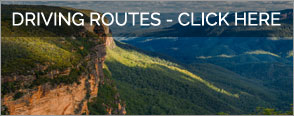One of the best ways to explore the worlds beyond the carparks in the Greater Blue Mountains is to take a mountain bike with you on your journey.
Alternatively leave the car at home, strap on the panniers and let your pedals to the talking as you take the slow road around the mountains.
- Cyclists are legally required to wear a helmet with a sticker saying the helmet has been approved by Standards Australia.
- Helmets should fit well, be securely fastened and checked regularly for damage.
- Cyclists should also wear a bright helmet, bright clothes and use other visibility aids such as reflectors and flags.
- When used on public roads, bikes must be fitted with a working brake and a bell. If used at night the bike must have a front and rear light and a rear reflector.
- When riding on public roads, cyclists should keep left and use a marked bicycle lane wherever possible.
- Always beware of oncoming traffic and pedestrians, even on remote management tracks.
- Ride on open trails only. Cycling is not permitted on most walking tracks unless signposted for shared use, nor on many trails in wilderness areas. Stay on the track.
- Always give way. Bicycles are faster than other trail users. When approaching others slow down to pass.
- Self-reliant cyclists carry enough water, snacks and basic tools to deal with common situations during their journey. They plan ahead, use maps, never ride alone in the bush and let others know where they are going.
- Mountain bike tours in remote areas should only be attempted by experienced, well-equipped riders.
- Avoid scaring animals.
- In all situations, control your bicycle. Avoid skidding, reduce erosion and ride within your ability.
- Leave no trace. Carry out everything you take in.





